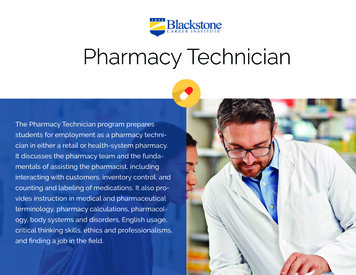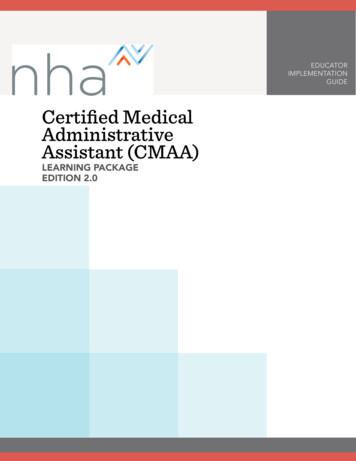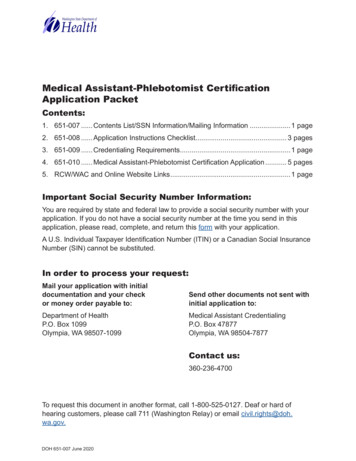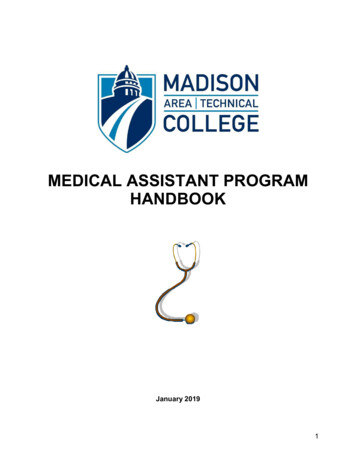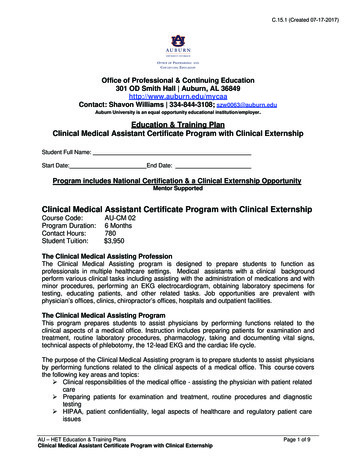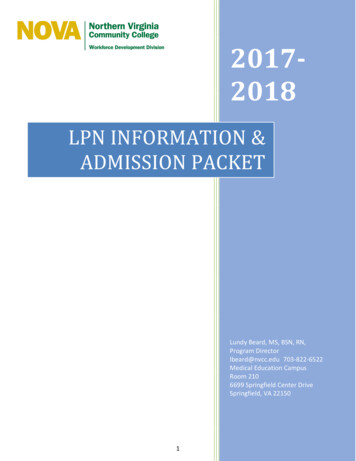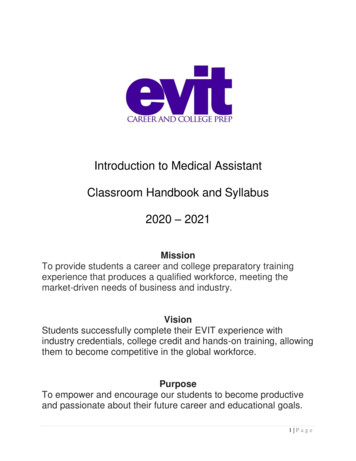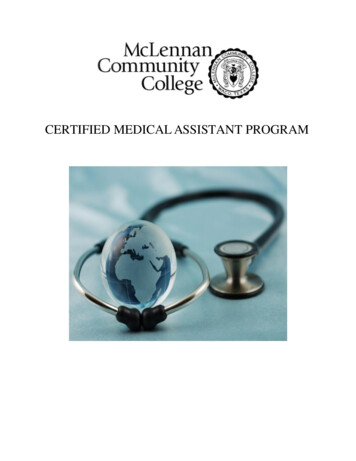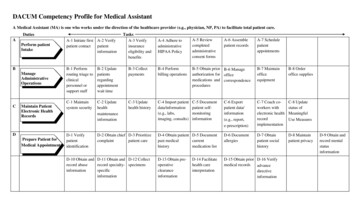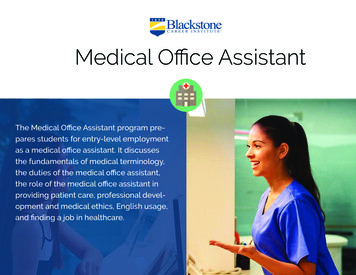
Transcription
Medical Office AssistantThe Medical Office Assistant program prepares students for entry-level employmentas a medical office assistant. It discussesthe fundamentals of medical terminology,the duties of the medical office assistant,the role of the medical office assistant inproviding patient care, professional development and medical ethics, English usage,and finding a job in healthcare.
The Medical Office Assistant programprepares students for entry-levelemployment as a Medical Office AssistantThere are no due-dates for any of your coursework and you have up to 18months to complete your program.To contact your Instructor Kimberly, please email instructor@blackstone.edu.Any general questions, please email info@blackstone.edu.Your course is broken down into units. Students who pay in full for their programhave access to all course materials. Students who enroll under a monthly payment plan have access to a new unit every month upon making theirmonthly payment.
The program is broken down into 18 study units.All course material is included in your tuition. Unit 1 - Blackstone’s Skills for Successpg. 1 Unit 2 - Introduction to Computers, Keyboarding and Office Technologypg. 1 Unit 3 - Anatomy and Medical Terminology 1: An Introductionpg. 2 Unit 4 - Anatomy and Medical Terminology 2pg. 2 Unit 5 - English Usage and Written Communicationpg. 3 Unit 6 - Time and Stress Managementpg. 3 Unit 7 - Anatomy and Medical Terminology 3pg. 4 Unit 8 - Anatomy and Medical Terminology 4pg. 4 Unit 9 - Administrative Medical Assisting 1pg. 5 Unit 10 - Administrative Medical Assisting 2pg. 5 Unit 11 - Professional Development and Medicolegal Ethicspg. 6 Unit 12 - Administrative Medical Assisting 3pg. 6 Unit 13 - Administrative Medical Assisting 4pg. 7 Unit 14 - Medical Office Practice 1pg. 7 Unit 15 - Medical Office Practice 2pg. 8 Unit 16 - Medical Office Practice 3pg. 8 Unit 17 - Creating an Effective Workplace Enviornmentpg. 9 Unit 18 - How to Find a Job in Healthcarepg. 9
Our graduates are eligible upon completion of theirMedical Office Assistant course to sit for nationalcertification through these organizations.Graduates of Blackstone Career Institute’s Medical Office Assistant training program are qualifiedto sit for the National Certified Medical Office Assistant (NCMOA) exam administered by the National Center for Competency Testing (NCCT). Certification provides further assurance of skills andknowledge to employers.Our online Medical Office Assistant Program is Nationallyand Regionally Accredited through the DEAC and MSA.It is important to check with the state licensing board orsimiliar regulatory body in the state you plan to work in.
What you receive with your programYour program consists of eighteen units, including the following commercial e-books and electronic resources, to assist youstep-by-step through the program.Kinn’s The Administrative Medical AssistantKinn’s The Administrative Medical Assistant is the most comprehensive text available for medical office assistant training. This e-bookedition provides current, reliable content in an engaging format,offering unparalleled coverage of the practical,real-world administrative skills needed in any healthcare environment. An activationcode will be e-mailed to you when you reach Unit 9. Textbook: Kinn’sThe Administrative Medical Assistant, by Alexandra P. Young. ISBN:9780323221030.Computers in the Medical Office (CiMO)The e-book Computers in the Medical Office provides a hands-onapproach to learning one of the most popular medical office billingand practice management software packages available. The ebookcomes with online access to a MediSoft V19 simulated practice program so that you can practice your skills using the same softwareused on the job. An activation code will be e-mailed to you when youreach Unit 14. Textbook: Computers in The the Medical Office, by Susan Sanderson. ISBN: 9780073402130.
What you receive with your programYour program consists of eighteen units, including the following commercial e-books and electronic resources, to assist youstep-by-step through the program.Stedman’s Medical Dictionary for the HealthProfessions and NursingThis online reference is yours for a full year! Youwill have access to more than 56,000 terms anddefinitions, more than 42,000 audio pronunciations,anatomical videos, and over 5,600 images.
Program Goals & Objectives Identify common learning strategies Describe how computers, internet and electronic communication impact the workplace today Identify common word elements in medical terms Identify common medical terms related to the organization of the body and the various body systems Analyze medical terms to determine their meaning Demonstrate knowledge of guidelines for grammar, punctuation, and written correspondence Evaluate written communications to identify problems and suggest solutions Describe the duties of a medical office assistant Demonstrate the correct way to schedule appointments, interact with patients over the telephone,interact with patients in the reception area, register patients, file documents and records, and processmail in the medical office Identify common health insurance systems used in the medical office Differentiate between a healthcare record and a medical report Describe the medical office assistant’s role in managing prescriptions and prescription drugs Compose effective resumes and cover-letters Consider ways to proactively search for work as a medical office assistant
Blackstone’s Skills for SuccessUnit 1In this lesson, you will discover how you learn as well as your learning style. You will understandhow you learn best by reading about intrinsic versus extrinsic motivation, field dependence andindependence, self-efficacy and self determination. Visual, auditory, and kinesthetic learners willbe discussed along with the differences between them. You will also receive some tips regardingyour study space, the best time to work, and goal setting. Also, basic keyboarding skills will beintroduced. Learning strategies, along with note-taking and memory tricks, are also an importantpart of this lesson. You will receive access to the Blackstone Typing Tutor.Introduction to Computers,Keyboarding and Office TechnologyUnit 2Lesson 2 covers how computers are used in the office today, the different types of computers, andthe parts of a computer system. In this lesson you will also learn about the Internet, URLs, searchengines, and e-mail. Office technology will be discussed, including office networks, different typesof servers, PDAs, scanners, digital cameras, and wireless communication.1
Anatomy and Medical Terminology 1:An IntroductionUnit 3This lesson begins your study of medical terminology. The lesson explains how medical terms areconstructed and analyzed to determine meaning; the parts of medical terms, including roots, prefixes, and suffixes; the function of combining vowels; and how terms are pluralized. The lesson alsointroduces the basic organization of the human body and discusses the body cavities, planes ofthe body, and directional terms. You will receive access to the e-book: Stedman’s Medical Dictionary for the Health Professions and Nursing Online.Anatomy and Medical Terminology 2Unit 4In this lesson, you will study four of the body systems—skeletal, muscular, integumentary (skin),and respiratory—and the relevant medical terms and abbreviations, as well as common injuriesand diseases.2
English Usage and Written CommunicationUnit 5In this lesson, you will gain knowledge about the English language and written communication. This information is important to the successful allied health professional. Begin with parts ofspeech, then review parts of a sentence, pronouns, verbs and finally sentence types and punctuation. This lesson is a great grammar tutorial or refresher. You will also learn about writing in activeversus passive voice, paragraph formation, and topic sentences; and you gain some valuable tipsfor business communication.Time and Stress ManagementUnit 6This lesson discusses how to minimize stress and maximize productivity in your personal and professional life by analyzing your values, habits, and daily interruptions. Multiple worksheets andexercises are included, as well as valuable tips for prioritizing and setting goals.3
Anatomy and Medical Terminology 3Unit 7This lesson covers the anatomy and physiology of the cardiovascular, urinary, digestive, andnervous systems, including the relevant medical terms as well as common diseases, tests andprocedures, and terminology abbreviations.Anatomy and Medical Terminology 4Unit 8This final anatomy and medical terminology lesson completes the study of the body, covering theendocrine and sensory (eyes and ears) systems; the blood, lymphatic and immune systems; andthe male and female reproductive systems. The lesson discusses diseases associated with thesebody systems and also lists common abbreviations for terms related to these systems.4
Administrative Medical Assisting 1Unit 9This lesson will introduce you to the administrative medical assisting profession. You will readabout professional behavior in the workplace, how to make a good first impression, and dealingwith conflict. You will learn about the history of ethics in medicine and making ethical decisions.This lesson also discusses medical professional liability, negligence and physician licensure. Youwill receive access to the e-book: Kinn’s The Administrative Medical Assistant.Administrative Medical Assisting 2Unit 10This lesson introduces health-system and retail pharmacies, their organization, and the roles thatpharmacy technicians play in each. You will learn about technology in the pharmacy, collectinginsurance information and how patient confidentiality applies to electronic data. Inventory management is discussed, including ordering, receiving and returns. Medication compounding, flavoring, and quality assurance are covered. This lesson also explores sterilization, aseptic techniques,equipment and supplies, sterile products and routes of administration.5
Professional Developmentand Medicolegal EthicsUnit 11In Lesson 11, you will read about professional development and medicolegal ethics. Attitude, selfesteem, professional attire, and grooming are all topics presented in this lesson. Also, business etiquette; verbal and nonverbal communication; proper introductions; and continuing education willbe discussed. You will read about ethics in healthcare, codes of ethics, and the purpose of healthcare records. Important information about making corrections, timeliness, and confidentiality isexplored in this lesson. This lesson also presents the HIPAA guidelines, discussing the Privacy andSecurity Rules, Protected Health Information, access control, deidentified information, and workarea security.Administrative Medical Assisting 3Unit 12This lesson discusses billing and coding procedures. You will learn about the basics of diagnosticand procedural coding. The types of health insurance and benefits are explained, as well as theprocesses for verifying insurance benefits, precertification, and preauthorization. The CMS-1500Health Insurance Claim Form is presented, including data gathering guidelines and how to preventclaim rejection and check a claim status. Professional fees, billing and collection techniques arealso covered.6
Administrative Medical Assisting 4Unit 13This lesson covers financial practice management, assisting with medical emergencies, and careerdevelopment. An overview of banking services and procedures, accounts payable and receivable,medical practice management, and marketing strategies are discussed. Common office emergencies are explained, as well as general rules for emergencies and tips for making the facility accident-proof. You will also explore job search techniques.Medical Office Practice 1Unit 14This lesson prepares students to start using MediSoft by introducing medical informatics, or theuse of computers and computer information technology in healthcare. The Windows environmentis covered, since it is important to be familiar with Windows terminology to fully utilize MediSoft.You will learn about the various uses of MediSoft, the MediSoft and Office Hours toolbars, andscheduling appointments using the Appointment Book. Access to online simulation exercises withMediSoft is included so you can practice navigating and using the program. You will receive access to the e-book: Computers in the Medical Office.7
Medical Office Practice 2Unit 15In this lesson you will learn how to enter, edit and save patient files and cases, as well as printreports on patient and case information. This lesson describes how to enter, edit and apply payments and charges, create and print claims, check the status of claims, and print a Deposit Listreport. You will also discover the process of submitting electronic claims, the information neededfor an electronic claim, and the differences between paper and electronic claims.Medical Office Practice 3Unit 16This lesson is composed entirely of a series of online exercises and Medisoft simulations designedto increase familiarity and skill with the program.8
Creating an EffectiveWorkplace EnviornmentUnit 17Lesson 17 provides an overview of successful workplace strategies, including how the variousroles in the office can function together and how to use feedback, goals and incentives for increasing productivity. This lesson will introduce you to the fundamentals of effective communication,including maximizing your speaking and listening skills and proper use of body language to communicate messages. You will also learn about the benefits of working in a culturally diverse environment, and how to overcome barriers caused by diversity. Finally, this lesson will explore teambuilding strategies.How to Find a Job in HealthcareUnit 18Lesson 18 focuses on finding a job in the healthcare field. Learn about job search correspondencesuch as writing resumes and cover letters, and how to conduct a job search including networking,online searches, and proactive job search techniques. You will learn how to prepare for an interview, including what to wear, what to expect, common questions that you might be asked, questions that you should ask, and how to follow up after an interview.9
The Administrative Medical Assistant, by Alexandra P. Young. ISBN: 9780323221030. What you receive with your program Your program consists of eighteen units, including the follow-ing commercial e-books and electronic r
